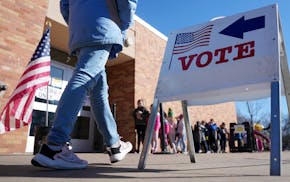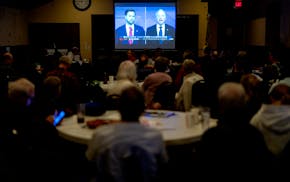Sen. Elizabeth Warren's visit to Minnesota last week drew thousands. Naturally her visit raises contrasts with Minnesota's own presidential candidate, Sen. Amy Klobuchar.
On issues like Medicare for All, Warren is no doubt to the left of Klobuchar, and thus warmer in the hearts of Minnesota's progressive activists.
But Klobuchar can answer that she can deliver what Democrats are really after — victory over President Donald Trump. She's won Republican counties before. She has hewed to a more centrist line that will appeal to the suburbanites with whom Democrats made major gains in 2018 and need to keep. And she's from the region of the country where the election will likely be decided.
In other words, she's more "electable."
It's a compelling argument, and one that's also being made by the front-runner, former Vice President Joe Biden
Here's the problem: It assumes that you know something about voter behavior, when in fact you aren't qualified to make that judgment — because no one is, according to political scientist Jonathan Bernstein.
"There's simply no good way to know which candidate will do best in the general election," he wrote in the New York Times recently.
Instead, Bernstein continues, "People are likely to decide that the candidate they like for other reasons — policies or personality or governing record or demographics — is probably also the one apt to do best against Trump. In other words, voters and party actors acting as pundits are likely to fall into a version of the pundit's fallacy: the tendency to conclude that whatever they like is also what's really popular."
Democrats also are debating a related question: Should they nominate someone who can supercharge the base and bring out new and infrequent voters? This is a mobilization argument. Or, should they pick someone who can flip Obama-Trump voters, as many Dems managed to do in 2018? This is a persuasion argument.
Not surprisingly, party moderates are usually the ones who think persuasion is the way to go, while progressives want a mobilization candidate.
Here we turn to Yair Ghitza of Catalist, a data analytics firm that works for progressive causes: "It is clear that both mobilization and persuasion were critically important in [2018] in producing this scale of victory for Democrats. When it comes to turnout, the composition of the electorate roughly 'broke even' with 2016," he writes. In other words, Democrats were successful in bringing about an unusual occurrence: The demographic composition of the midterm electorate was similar to the 2016 presidential. That's mobilization.
But he also adds that "a large portion of gains came from people who voted in both elections, switching from supporting Trump in 2016 to supporting Democrats in 2018." That's persuasion.
When it comes down to it: Who knows?
Former DFL Senate Majority Leader Kari Dziedzic dies of cancer at age 62

How the Star Tribune is covering the 2024 election

Fact check: Walz and Vance made questionable claims during only VP debate

In Tim Walz's home city, opposing groups watch him debate on the national stage

